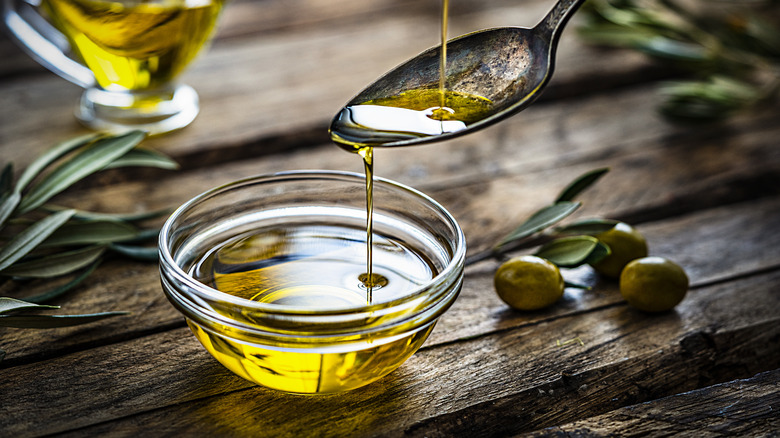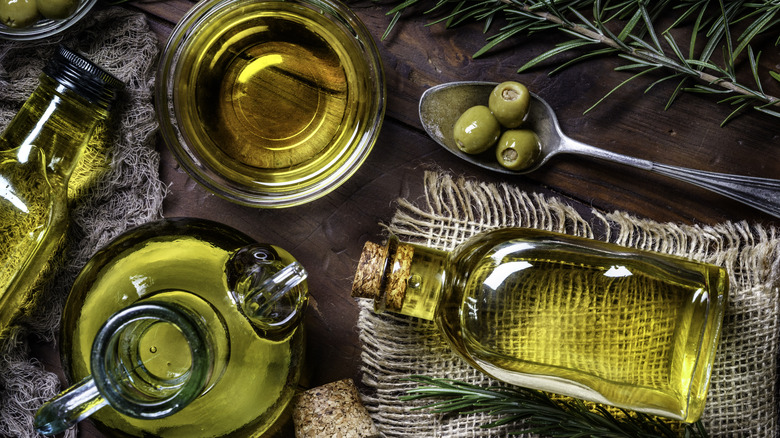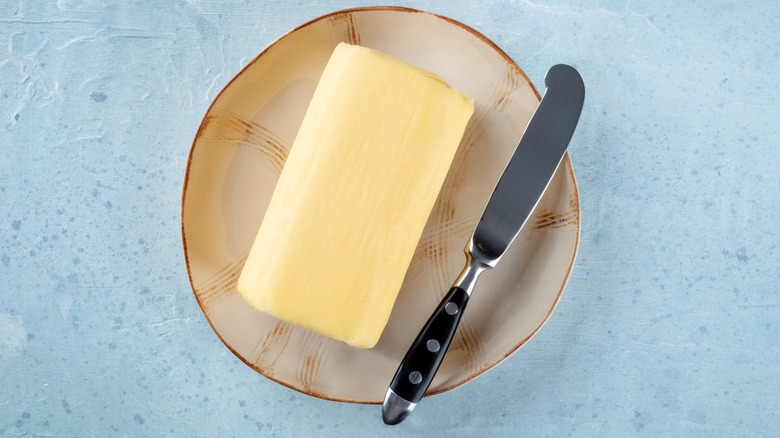The Olive Oil Hack To Get Precise Measurements For Sticky Ingredients
Natural ingredients like maple syrup and honey are the preferred sweeteners for many home cooks who want to avoid refined sugars in their recipes. Unfortunately, sticky ingredients are complicated and messy to measure — does anyone actually know whether to use a liquid or dry measuring cup for marshmallow spreads? While you can eyeball some ingredients to make a glaze or sweeten a vinaigrette, precision is critical when it comes to baking with sweeteners.
You've heard it before: Baking is a science requiring exact measurements to achieve consistent results. Leaving remnants of honey, peanut butter, or molasses in a measuring cup won't just affect the taste of your baked goods — it could alter their texture, too. Viscous ingredients like honey can contain anywhere from 14% to 20% water, so leaving some in your measuring cup could make your baked items less sweet and drier than anticipated.
To prevent sticky ingredients from clinging to measuring cups and spoons, use one of Martha Stewart's best kitchen hacks: grease your utensils first. Using a pastry brush, paper towel, or finger, lightly coat the inside of the measuring cup or spoon with a bit of olive oil, creating a nonstick surface. The small amount of olive oil won't affect the flavor of the final dish, but will ensure precise measuring, since the sticky ingredient will slide right out. While all varieties of olive oil will do the trick, not all are recommended for every recipe.
What is the best type of olive oil to use?
If you prepare a lot of Mediterranean food, chances are you have more than one bottle of olive oil in the kitchen, with different types like extra-virgin, virgin, cold-pressed, unrefined, and light. Each olive oil variety is well-suited for particular dishes and cooking methods, such as frying versus dipping, and they vary in color (from dark green to golden-hued), flavor, intensity of pepperiness, and quality (often evident by the price point).
If the recipe calls for a specific olive oil, like extra-virgin for a delicious Greek Grape Molasses Cake, begin by measuring the oil first, then reuse the greased measuring cup for sticky ingredients like molasses. This hack not only saves you from cleaning an extra item, but also aligns with the dish's flavor profile.
If olive oil isn't used in the recipe, choose an oil with a neutral flavor that won't alter the taste of your baked goods. Using the expensive EVOO finishing oil you brought back from a trip to Tuscany would be a waste. Instead, opt for regular or light olive oil, which is typically cheaper.
Other oils and fats to use
If you don't have olive oil on hand, there are other fats you can use to grease measuring cups and spoons. If possible, pick a fat that is already listed in the recipe. If butter is called for, use its wrapper to apply a thin, greasy layer to the utensil before discarding it. You only need to use enough to turn the inside of a liquid measuring cup into a nonstick surface to accurately measure pourable, sticky ingredients like honey, molasses, or maple syrup. As a tip, remember that room temperature or warmed sticky ingredients are faster and easier to pour than cold ones.
Other good options include nonstick cooking sprays and neutral-tasting oils like vegetable, canola, and grapeseed. Cooking sprays are particularly helpful since they are available in different varieties to complement the dish. Intensely flavored fats, such as coconut and sesame, might leave a hint of their flavor behind, so avoid using them unless you think they would make a good addition to the recipe.



